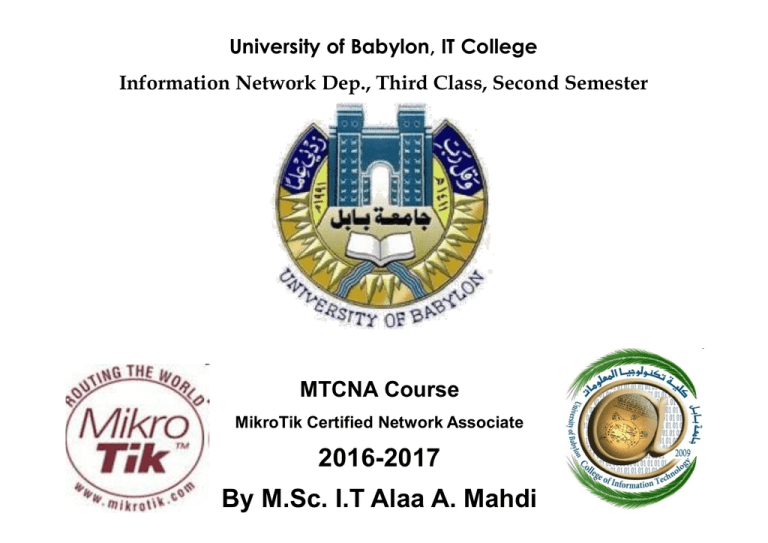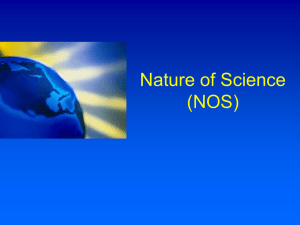Document 12927591
advertisement

University of Babylon, IT College Information Network Dep., Third Class, Second Semester MTCNA Course MikroTik Certified Network Associate 2016-2017 By M.Sc. I.T Alaa A. Mahdi Network Operating Systems NOS • Every network today has some form of software to manage its resources. This software runs on a special, high-powered computer and is called a network operating system (or NOS, for short). The NOS is one of the most important components of the network. A networking operating system (NOS) is the software that runs on a server and enables the server to manage data, users, groups, security, applications, and other networking functions. The most popular network operating systems are:* Microsoft Windows Server 2003/ 2008, * UNIX, Linux, * Mac OS X, and * Novell NetWare. Network Operating Systems are based on a client/server architecture in which a server enables multiple clients to share resources. Network Operating Systems (NOS) are embedded in a router or hardware firewall that operates the functions in the network layer (layer 3) of the OSI model. • Examples: • Cisco IOS (formerly "Cisco Internetwork Operating System"). • MikroTik RouterOS™ (is a router operating system and software which turns a regular Intel PC or MikroTik RouterBOARD™ hardware into a dedicated router.) Client/Server Client/server: Network operating systems allow the network to centralize functions and applications in one or more dedicated servers. The server is the center of the system, allowing access to resources and instituting security. The network operating system provides the mechanism to integrate all the components on a network to allow multiple users to simultaneously share the same resources regardless of physical location. NOS Characteristics The function of an operating system (OS) is to control the computer hardware, program execution environment, and user interface. The OS performs these functions for a single user or a number of users who share the machine serially rather than concurrently. An administrator may set up accounts for more than one user, but users cannot log on to the system at the same time. In contrast, network operating systems (NOSs) distribute their functions over a number of networked computers. A NOS depends on the native OS in each individual computer. It then adds functions that allow access to shared resources by a number of users concurrently. • NOS computers take on specialized roles to accomplish concurrent access to shared resources. Client systems contain specialized software that allows them to request shared resources that are controlled by server systems responding to a client request. Figure below illustrates the concept of how data that is stored in servers is made available to the requests of clients. Differences between PCs and a NOS • PCs function as clients in a NOS environment. By using the functions of the PC native operating system, the user is able to access resources that are local to the PC. These include applications, files, and devices that are directly attached such as printers. When a PC becomes a client in a NOS environment, additional specialized software enables the local user to access nonlocal or remote resources as if these resources were a part of the local system. The NOS enhances the reach of the client PC by making remote services available as extensions of the local native operating system. Although a number of users may have accounts on a PC, only a single account is active on the system at any given time. In contrast, a NOS supports multiple user accounts at the same time and enables concurrent access to shared resources by multiple clients. Servers must support multiple users and act as repositories of resources that are shared by many clients. Servers require specialized software and additional hardware. Figure below illustrates this concept further. The server must contain several user accounts and be capable of allowing more than one user access to network resources at a time. 15 Multiuser, multitasking, and multiprocessor systems • In order to support multiple concurrent users and to provide shared access to network services, resources, and devices, NOS servers must run operating systems with characteristics that extend beyond those of client PCs. A NOS server is a multitasking system. Internally, the OS must be capable of executing multiple tasks or processes at the same time. Server operating systems accomplish this with scheduling software that is built into the execution environment. The scheduling software allocates internal processor time, memory, and other elements of the system to different tasks in a way that allows them to share the systems resources. Each user on the multiuser system is supported by a separate task or process internally on the server. These internal tasks are created dynamically as users connect to the system and are deleted when users disconnect. NOS Characteristics 1- Network Operating Systems (NOSs) distribute their functions over a number of networked computers. 2- It adds functions that allow access to shared resources by a number of users concurrently. 3- Client systems contain specialized software that allows them to request shared resources that are controlled by server systems responding to a client request. 4- The NOS enhances the reach of the client PC by making remote services available as extensions of the local native operating system. 5- NOS supports multiple user accounts at the same time and enables concurrent access to shared resources by multiple clients. 6- A NOS server is a multitasking system. Internally, the OS must be capable of executing multiple tasks or processes at the same time. 7- Some systems are equipped with more than one processor, called multiprocessing systems. They are capable of executing multiple tasks in parallel by assigning each task to a different processor. • 8- NOS servers are a computers with additional memory to support multiple tasks that are all active, or resident, in memory at the same time. • 9- Additional disk space is also required on servers to hold shared files and to function as an extension to the internal memory on the system. Another feature of systems capable of acting as NOS servers is the processing power. Ordinarily, computers have a single central processing unit (CPU) that executes the instructions which make up a given task or process. In order to work efficiently and deliver fast responses to client requests, an OS that functions as a NOS server requires a powerful CPU to execute its tasks or programs. Single processor systems with one CPU can meet the needs of most NOS servers if they have the necessary speed. To achieve higher execution speeds, some systems are equipped with more than one processor. Such systems are called multiprocessing systems. They are capable of executing multiple tasks in parallel by assigning each task to a different processor. Enterprise servers are also capable of running concurrent copies of a particular command. This allows them to execute multiple instances of the same service or program call threads. A thread is a computer programming term that describes a program which can execute independently of other parts. Operating systems that support multithreading enable programmers to design programs whose threaded parts can execute concurrently. MikroTik RouterOS • MikroTik Router OS is an operating system which can be installed on a PC or RouterBOARD hardware and will turn them into a router with all the necessary features: • Routing, • Firewall, • Bandwidth management, • Wireless Access Point, • Hotspot Gateway, • VPN server and more. RouterBOARD RouterBOARD is the hardware platform made by MikroTik.





